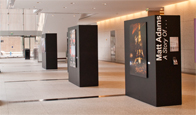FAQ
Q: Why “Imagery”
A: Because there are many tools to turn a regular “photograph” into a piece of art. What I offer is a body of options for the collector/decorator. These options include unretouched photographs, moderately retouched photographs, photographic art such as collages, and other techniques not associated with a strict “photographer”.
Q: I want an image of _________. Can you help with that?
A: Custom shoots can be a very stimulating exercise and satisfying for both the artist and the client. Such projects are considered on a case-by-case basis and planned out appropriately. Fun and creativity on the client’s part are required, however.
Q: What kinds of materials can you print on?
A: Please see the Media Options below.
Q: What sizes are available?
A: The most popular size is 10” x 15”. There are, of course, instances where larger sizing is desired. In these cases, the following must be stated. As an image is enlarged, graininess may occur, the degree of which is proportional to the amount of the enlargement. Some subject matter can actually look better with some graininess whereas other subjects are not as suited to such alteration. Further, there’re the affects of different print media. In providing custom imaging services, there have been experiences of both the acceptable and unacceptable variety.
Q: Can I view prints in person?
A: If you’re in the Houston , TX area, an Art Review appointment can be made. If you’re outside the area, review proofs can be supplied via mail service. Please click here to inquire.
Q: After I buy something, can I use it to make other copies or cards or napkins, etc.?
A: Matt Adams retains the copyright to all images sold. If other print sizes, objects, etc. are desired, simply click here to inquire. Your respect for my work is appreciated.
Print Media
All images provided by me are printed with archival quality inks. The medium upon which an image is best presented depends a lot on the content of the image. For example, high contrast subject matter looks best on glossy paper. However, portraits are better suited to paper that’s not glossy and foliage images may look better on glossy paper or not. I will provide prints on media that accentuates the subject matter. However, as all things go, there are custom options available.
The most commonly used materials are as follows:
Photographic paper including luster, glossy and matte finishes
Watercolor Paper
Velum
Canvas
Framing/Mounting Tips
There are many ways in which an image can be presented. Options include:
Framing with metal or wood moulding
Mating with a single or multiple mats. Or, no mat at all.
Frame-within-a-frame
Float frame (no mat)
Stretched canvas (with or without museum mount)
There are also considerations regarding mounting hardware, archival or conservation materials and types of glass. There are many quality custom framers to help you make your presentation a great one.
I typically provide only prints but may be able to assist you with some questions or design issues regarding professional framing/mounting.
Caring For Your Art
Conservation Glass
The purpose of professional framing is to provide protection as well as presentation. One of the most important components in providing protection is the glass. Glass serves as a barrier between the artwork and outside elements such as dust, moisture, curious observers and most importantly, light.
Light is the source of all our visual pleasure in art; and ironically it is also the environmental factor which is most threatening to the preservation of many works of art. Damage from light is cumulative and irreversible. The rate and amount of damage depends on both the quantity and quality of the light falling on the artwork.
The UV portion of the spectrum, which is invisible, is called ultraviolet or UV light. The same UV light that causes sunburn and wrinkles can affect framed art depending on intensity and duration of exposure. The best way to help prevent this damage is to put UV-blocking glass in your frame. Conservation glass has an invisible coating that blocks over 97% of damaging UV light without affecting the look of your framed image.
Be warned, however – when you preserve your photos with conservation glass, expect to pay about twice as much for the glass.
Care for Unframed Prints
Lay your unframed prints flat and store them in a dry place away from sunlight.
Unframed prints can be stored in a tube for a short period of time.
Store valuable prints between sheets of acid-free paper, mat boards or foam core.
Prints can also be stored in clear Mylar D or polypropylene sleeves since they do not contain PVC, which will damage art.
Care for Framed Art
Since heat can damage artwork, do not hang it near a fireplace, radiator or other heat sources.
Do not hang artwork on the outside wall of a room. Outside walls have fluctuating humidity that can cause condensation that can damage your artwork.
Do not hang artwork in direct sunlight or direct fluorescent lighting. Ultraviolet rays from these two light sources will fade your artwork.
How to Clean Framed Art
If your artwork is framed with glass, do not spray glass cleaner directly onto the glass. It may seep under the edges of the glass and damage the mats and/or artwork. Instead, spray the glass cleaner onto a towel or paper towel and then clean the glass.
To dust artwork framed with acrylic or Plexiglas, use a soft cloth. Do not use a paper towel, as it will scratch the surface of the Plexiglas. Do not spray cleaner directly onto the surface. Instead, spray the cleaner onto a soft cloth and then clean the acrylic or Plexiglas.

